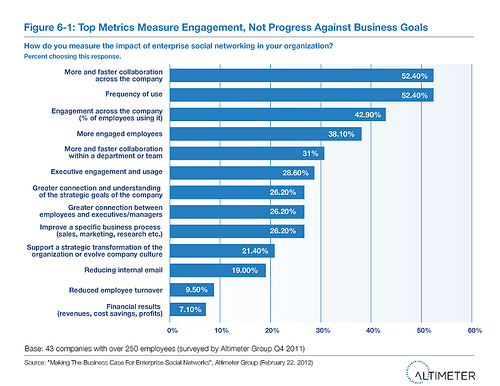- Category: May / June 2012 - Social Media Marketing

- Encourage sharing.
- Capture knowledge.
- Enable action.
- Empower employees.

This is the first of two reports on enterprise social networks,with this one focused on how it creates value for organizations. The next report will focus on maturity models and the future of enterprise social networks.
Data Highlights
The report also includes input from 13 technology providers, 185 end users, and surveyed 81 ESN decision makers from companies with over 250 employees (see below in Related Resources for links to the data). A few of the findings and graphics from the report are included below. There was only moderate impact on business goals. On a scale of 1 to 4, the highest impact seen – improving collaboration between departments/teams — scored only a 2.91 (see Figure 5 below).A key reason for this is that there were few metrics used to gauge effectiveness. Most metrics were engagement-oriented in nature and not necessarily tied to business impact. For example, the top three metrics used were 1) More/faster collaboration across the company; 2) Frequency of use; and 3) Engagement across the company (% of employees using it) (see Figure 6-1 below).

In fact, no organization surveyed believed they measure ESNs very well, and only 31% felt they measured ESN impact somewhat well. A quarter admitted that they didn’t measure at all! (see Figure 6-2 below).

Four Ways Enterprise Social Networks Drive Value
Despite the promise and potential for ESNs, they have only received moderate traction. The problem is that most ESN deployments to date have been treated as technology deployments with a focus on adoption and usage. A different way to think about this is that ESNs represent a new way to communicate and form relationships — and because of that, can bridge gaps that exist in terms of information sharing and decision-making processes. To better understand these use cases, we found that they boil down to four different types of gaps in the organization — tough problems that can’t be addressed by the current technology, process, or culture.- Encourage sharing. Remember how revolutionary email was? It fundamentally changed the way we communicated by reducing the cost/effort and collapsing the time frame and scaling it to include multiple recipients. Social represents a fundamental change, simply because, at its essence, it encourages sharing. The simple presence of a status update box on a page encourages people to share their thoughts, activities, and expertise.
Capture knowledge. Capturing the collective knowledge of an organization is a daunting task because it includes a wide range of facts, information, and skills gained through experience. Yet few people proactively sit down each day to document and capture their knowledge. ESNs provide an opportunity to do just that, by capturing glimpses of knowledge through profiles, activity streams, and interactions.
Enable action. Having an ESN in place means that operations and processes can begin to change as well. This happens when the day-to-day process changes because the ESN enables new relationships and behaviors that address a gap that prevented actions from being taken.
Empower employees. The last way ESNs drive value is that they empower and embolden people to speak up and join together, as well as gives them opportunities to contribute their skills and ideas.
Enterprise Social Network Action Plan
To be successful with your ESN, you need thus to focus on how relationships can close the gaps of information flows and decision making in your organization. To do this, you should take four steps, with your technology selection coming last, not first.
By Charlene Li, Altimeter



















